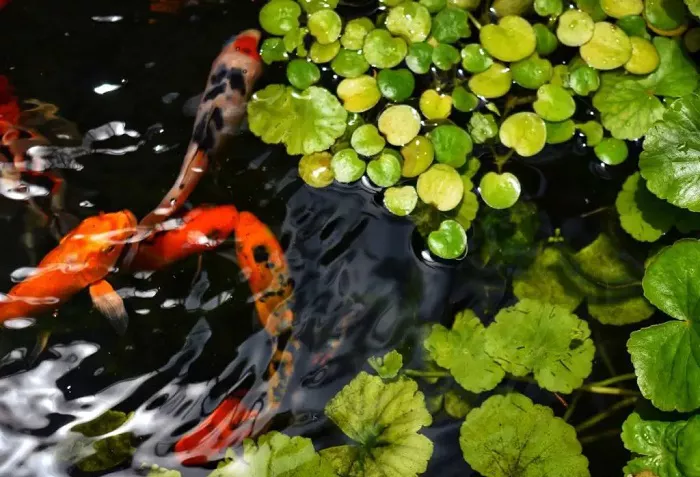Koi ponds are a serene addition to any garden, bringing life and tranquility with their colorful inhabitants. However, koi can be quite voracious eaters, often nibbling on plants. Finding plants that koi will leave alone is essential for maintaining a balanced and beautiful aquatic environment. This article explores a variety of plants that can thrive in and around koi ponds without becoming a koi buffet.
Aquatic Plants for Koi Ponds
Floating Plants
Floating plants are a great choice for koi ponds as they provide shade and oxygen while often being less appealing to koi. Water lettuce (Pistia stratiotes) is a popular option. Its feathery roots dangle into the water, offering a natural filtration system and a hiding spot for fry. Koi generally avoid eating water lettuce due to its tough texture and fibrous roots. Another excellent floating plant is water hyacinth (Eichhornia crassipes). With its attractive purple flowers and thick leaves, it adds visual interest to the pond. Koi tend to stay away from it because of its waxy leaf surface and dense root system.
Submerged Plants
Submerged plants are crucial for maintaining water quality by absorbing excess nutrients. Anacharis (Elodea canadensis) is a versatile submerged plant that grows quickly and helps keep the water clear. Koi usually avoid it because of its tough, stringy texture. Another submerged plant to consider is hornwort (Ceratophyllum demersum). Its feathery green foliage provides excellent cover for fish while deterring koi from eating it due to its prickly texture.
Marginal Plants
Marginal plants grow around the edges of the pond and can add a natural look to the landscape. Cattails (Typha spp.) are a classic choice for pond edges. Their tall, reed-like stems and distinctive brown seed heads create a rustic feel. Koi are unlikely to eat cattails because of their tough, fibrous stems. Irises (Iris spp.) are another beautiful marginal plant option. With their vibrant flowers and sword-like leaves, they add color and texture to the pond’s perimeter. Koi tend to avoid irises due to their tough leaves and the presence of natural compounds that deter herbivory.
Plants to Avoid in Koi Ponds
Sensitive Plants
Some plants are highly sensitive to koi activity and may not survive well in a koi pond. Water lilies (Nymphaea spp.), while beautiful, can be a favorite food of koi. Their tender leaves and flowers are often nibbled on, making it difficult for them to thrive. If you still want to include water lilies, consider placing them in a separate section of the pond where koi cannot easily access them.
Fragile Plants
Fragile plants with delicate stems and leaves are also not ideal for koi ponds. Water ferns (Azolla spp.) are small, floating plants that can quickly become a koi snack. Their soft texture makes them an easy target for hungry fish. Similarly, duckweed (Lemna spp.) is another floating plant that koi may consume readily. While it can provide some surface cover, it is not recommended if you want to maintain a stable plant population in the pond.
Creating a Koi-Friendly Pond Environment
Plant Selection and Placement
When selecting plants for your koi pond, consider their growth habits and the environment they need to thrive. Place floating plants in areas where they can provide shade and oxygen without being easily accessible to koi. Submerged plants should be anchored securely to prevent them from being uprooted. Marginal plants can be placed in pots or planted directly in the soil around the pond’s edge.
Providing Alternatives for Koi
Koi are natural foragers and will often nibble on plants if they are hungry. To prevent them from eating your pond plants, consider providing alternative food sources. Adding a variety of sinking pellets and vegetables can help satisfy their dietary needs and reduce their interest in plants. Additionally, including some hardy plants that koi tend to avoid can provide a natural barrier and protect more delicate species.
Regular Maintenance
Maintaining a healthy pond environment is crucial for both koi and plants. Regularly clean the pond to remove debris and excess algae. Monitor the water quality and adjust the pH and nutrient levels as needed. Prune plants to encourage healthy growth and remove any damaged or diseased leaves. By keeping the pond in good condition, you can create a balanced ecosystem where both koi and plants can thrive.
Conclusion
Creating a koi pond with plants that koi will not eat is essential for maintaining a harmonious and beautiful aquatic environment. By choosing the right plants and providing proper care, you can enjoy the beauty of both koi and plants in your garden. Floating plants like water lettuce and water hyacinth, submerged plants like anacharis and hornwort, and marginal plants like cattails and irises are all excellent options that koi tend to avoid. With careful planning and regular maintenance, your koi pond can become a thriving oasis in your garden.


